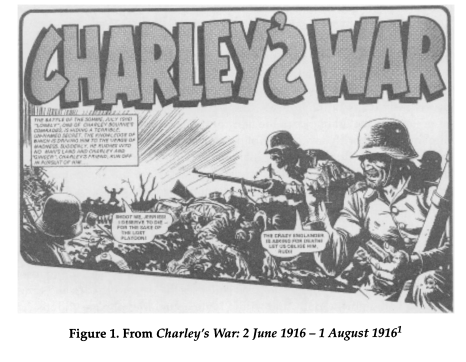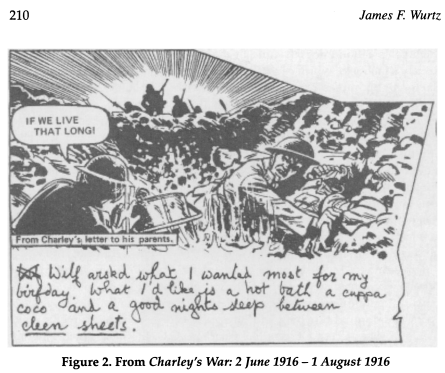Welcome, all, to this discussion of the morality, influence, and aesthetic of the World Wars and the effect they had on the industry of graphic novels! We have linked many details, comic books, and individual panels to the Second World War, in particular. Now, I would like to bring to your attention to a philological analyzation of the literature of the World Wars and how the multiple texts which the events have birthed have influenced many peculiarities singular to the graphic novel. Written by James F. Wurtz, "Representing the Great War: Violence, Memory, and Comic Form" outlines the key ways in which literature, current events, and personal experience have shaped the stylistic approaches and hidden meaning rooted in comic books such as, Charley's War. This comic strip, published in the British Battle Picture Weekly comic book series, takes a distinctive view on the World Wars and delivers a subtle, yet powerful anti- war message. Wurtz states, "Carefully researched, his [Charley's] story maintained a firm grounding in the reality of daily life in the trenches while presenting its anti-war message in terms that readers could both understand and enjoy reading." (207). When discussing comic literature, Wurtz introduces the idea that many assume the position that this literary and artistic form is childish and meant for a young audience. Although this is true for some comics, Wurtz explains that Charley's War uses a combination of unusual, 'non- linear' images, or 'signposts', which do not appear in a set order to create a deeper meaning, allowing older readers to enjoy the book as well. "Charley's War, however, makes careful use of its visual and verbal "signposts," creating a disjunction between narrative and representation that rejects linearity and thus allows the "hidden political significance" to emerge." (Wurtz, p.206). He goes on to explain that coupled with well- written captions, the comic portrays a virtuosic work meant for readers of all ages. "The dialogue and the captions are clearly aimed at a younger audience, but the complexities of the art and the relationship between the pictures and the words undermine the idea that this is children's literature."(Wurtz, p.207). This consideration is notable, because it secures the literary magnitude and depth of the comic book. On a side note, it seems that Pat Mills and Joe Colquhoun, the authors of the novel, have found the perfect middle ground and literary medium to project their ideas of World War I & II to an audience of all age groups. Going deeper into the subject, Wurtz begins to analyze the characters which are used in comic books, and what races are associated with either friend or foe. He himself writes, "With a clear-cut enemy to fight against, heroes like Superman, Captain America, Daredevil, and the Human Torch sold comics as they battled stereotypical Nazis and caricatures of Japanese soldiers." (206). In making this observation, Wurtz urges us to make the connection between historical events and the races used in comics to illustrate enemies and comrades, alike. The author continues describing attributes of the Charley's War which point to the traditions, personal accounts, and internal conflicts surrounding the World Wars. He introduces the argument that this interpretation of war, in general, in combination with aesthetically pleasing art can be used to advance the business model of the publication, and in effect, the work can lose its profound meaning. "When memory becomes commodity, it becomes available for consumption to any one. Likewise violence, rendered artistically and sold, loses its referent and so loses its impact." (Wurtz, p.213). His point is that by interpreting comics from an aesthetical viewpoint, war, itself, becomes beautiful, as any work of art. However, Wurtz maintains that Charley's War is an exception to his previous claim. "Charley's War portrays the violence of the war with the specificity of detail and the emotional impact of the abstract in order not to de-commodify but to represent the destruction of the Great War in such a way as to make impossible any interpretation of violence as beautiful." (Wurtz, p.214). This concludes Wurtz's article, and provides us with the full theory of the artist on the subject of the Wars influencing comic book style, content, and marketing.
Taking into account the arguments, observations, and opinions of James F. Wurtz, a firm connection can be established between his work and the assertion of World Wars influencing the races of post-war comic book heroes and villains. Wurtz proves through his analyzation of Charley's War that the political, social, and subliminal meaning behind comic books can be very complex, and simply dismissing them as a child's form of entertainment cannot be justified. This exact meaning varies throughout the differing stories of superheroes, but in this case, the message against war is crystal clear. It can be inferred that the writer and illustrator of this comic did not realize the shortcomings of their comic in the area of equality, since their moral is one of peace and prosperity. That being said, the authors still did not use much racial variation when it came to races not directly involved with the Second World War. Perhaps this is due to the personal experience the men had with the war. On the other hand, business aspirations and the views of common people who bought the books must have also played a role in the decision, or non-decision, of including other races such as African Americans in the comics. Whatever the influencing factor may be, comic books of different origin throughout the United States demonstrate the same patterns of predominance of white characters, and I stand beside my original idea of the World Wars inhibiting equality in comic books, whether it be due to personal experience, sociological standpoints, or business endeavors.


No comments:
Post a Comment